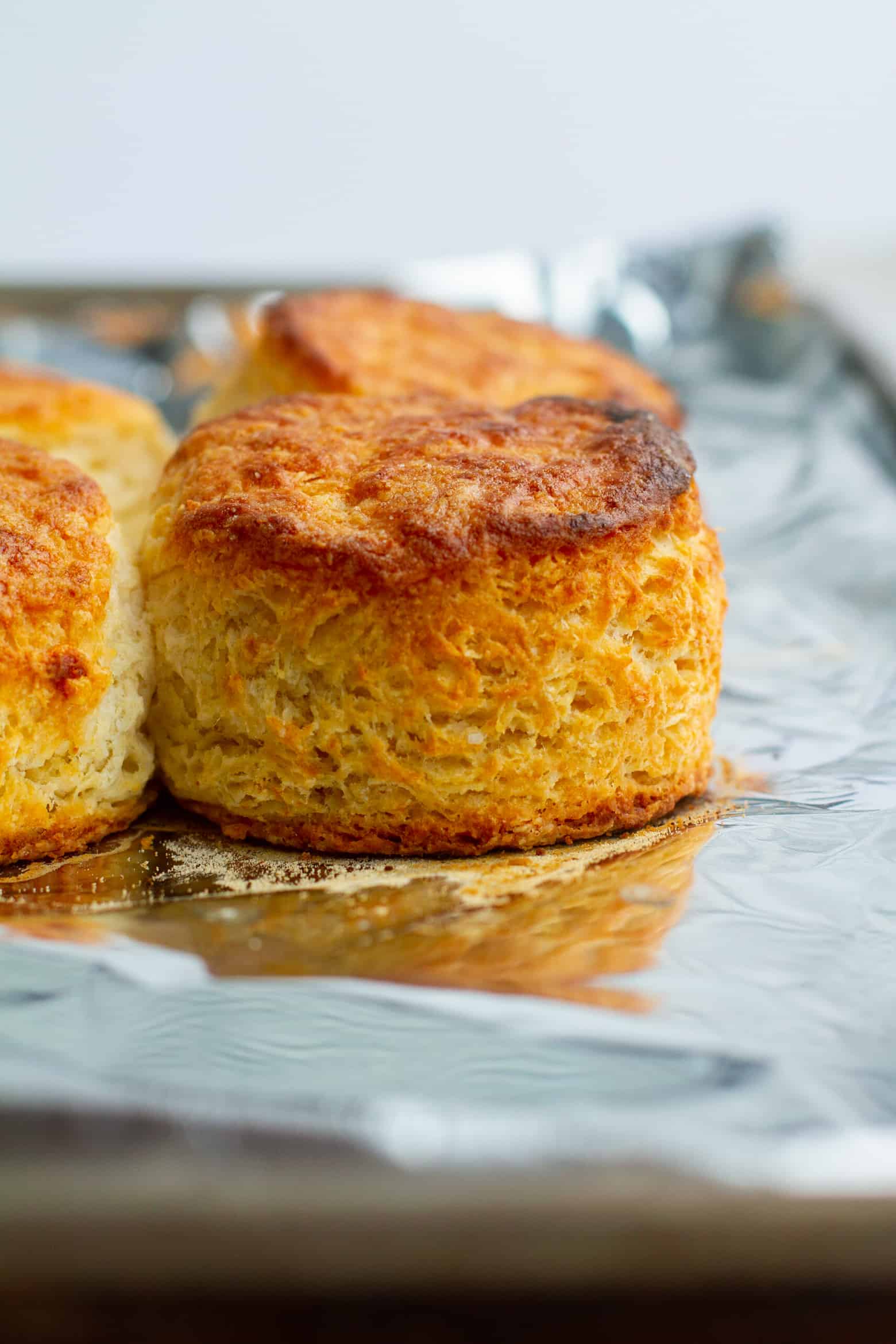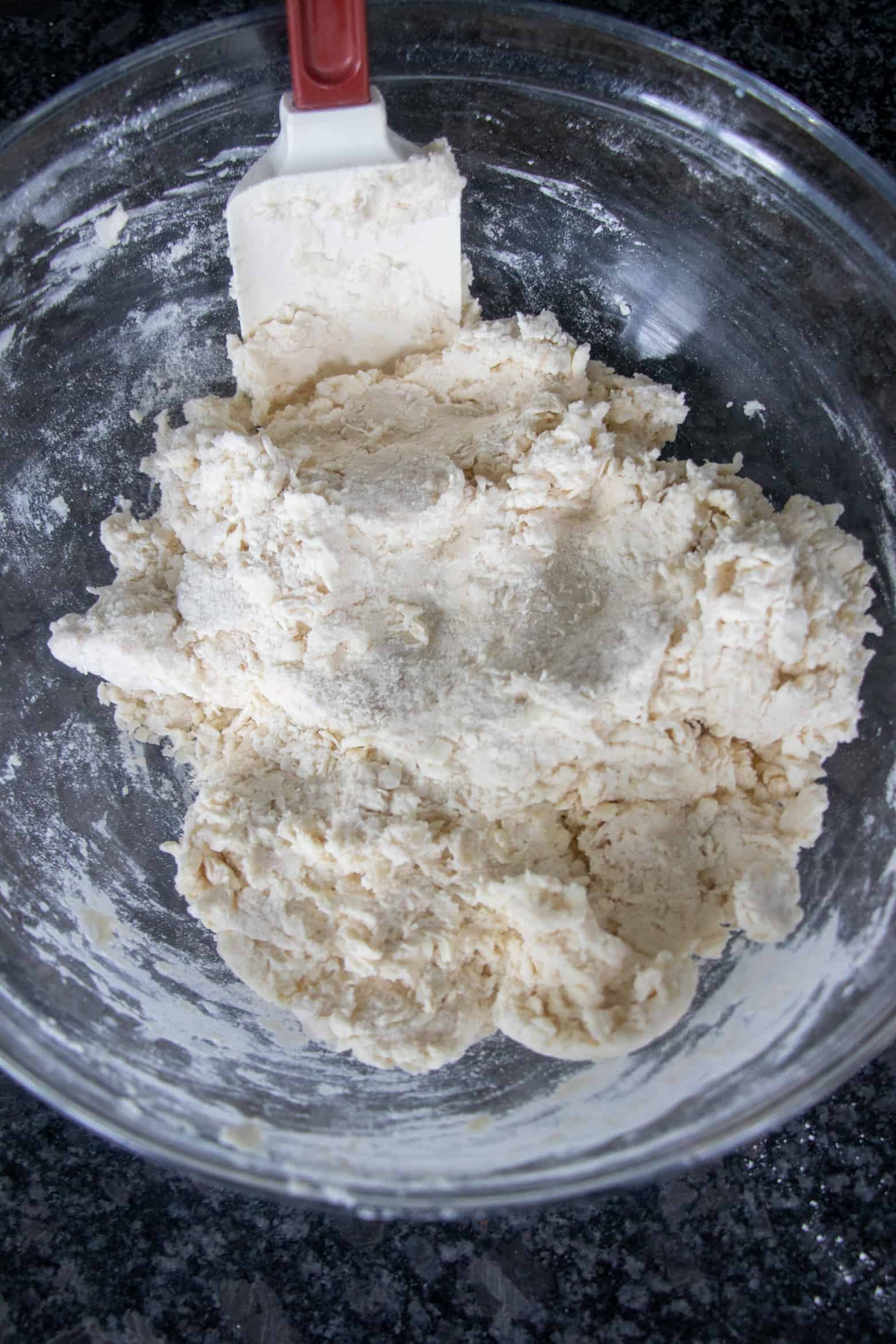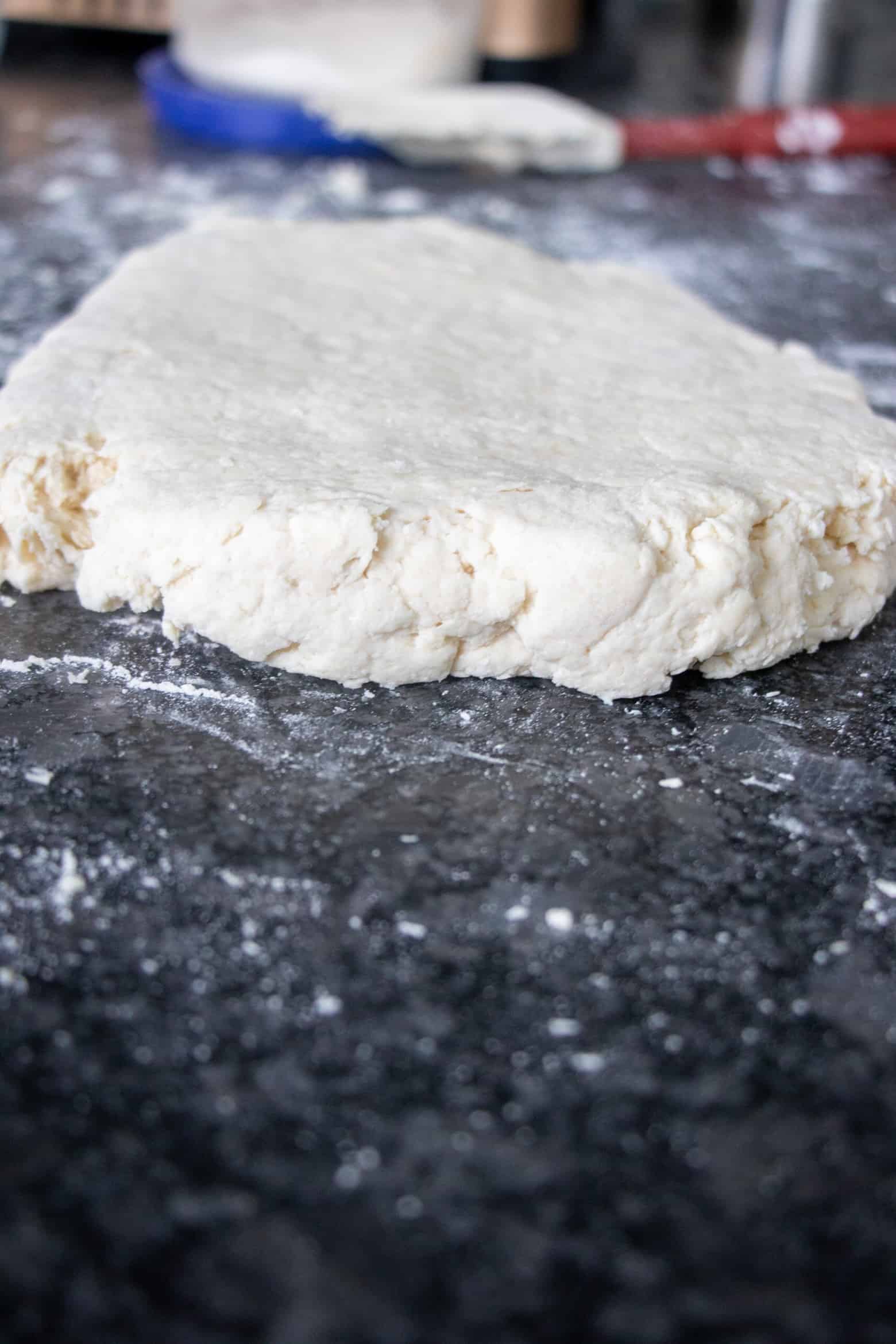This post may contain Affiliate Links. Please see my Disclaimer for more details.
These versatile Flaky Biscuits are tall, fluffy, buttery, tender, and golden brown. They're sure to impress everybody you serve them to.
What do you serve buttermilk biscuits with? Here are a few options: Buttermilk Fried Chicken Tenders, Red Beans and Rice, White Wine Chicken Pasta, Creole Oxtails, and Cajun Fried Fish & Grits.

Latest Recipe Video:
Jump to:
I'm a biscuit connoisseur. No, seriously, anywhere that offers biscuits, I will try it, even when it's against my better judgment. I'll try biscuits at the hotel breakfast and then Yelp the best biscuits in town just to see how my homemade buttermilk biscuits rank against them.
I take pride in baking biscuits.
This recipe, from texture alone, will give many restaurant recipes a run for their money. The flavor is buttery and pleasant, and it tastes excellent with various toppings, such as sausage gravy, honey butter, or fried chicken.
My goal for these was to skip a step that I find tedious when making flaky biscuits: laminating. That's the process of rolling the dough out, folding it like a paper to fit inside an envelope, dusting it with flour, and repeating it about five to seven times. This creates a crazy amount of beautiful, flaky layers.

However, I like to make delicious food in the shortest amount of time. These flaky layers are thin, but this technique produces tall and fluffy biscuits with a lovely crisp texture.
For my biscuit recipe, you'll need all-purpose flour, frozen butter, buttermilk, baking soda, baking powder, granulated sugar, and kosher salt.
I've known about the technique of grating frozen butter for decades, but I only thought it was worth the effort once I tested this recipe a couple of times. It gives me the best results for taller biscuits. Getting in your belly takes about 25 minutes from start to finish. Then, it's up to you to serve them for breakfast, lunch, dinner, or dessert.

Flaky Buttermilk Biscuits Ingredients
Here are the key ingredients to whip up these yummy golden brown buttery biscuits.
All-Purpose Flour
You can make homemade biscuits with a few flour options, but you need all-purpose flour for this recipe. I like to use unbleached flour because the higher protein makes for a sturdier biscuit.
Unsalted Butter
The key to tall, buttery biscuits is very cold butter, so I use grated frozen butter inside my biscuit dough. You'll also need some melted butter to finish them off.
Cold Buttermilk
Bulgarian buttermilk has the best flavor, so use it if you can find it. If not, the low-fat buttermilk will work. Wait to measure your buttermilk until the last second to ensure it's cold.
Baking Powder and Baking Soda
Combining both gives the biscuit height and helps create a crisp and crunchy top.
Granulated Sugar
Sugar is one of those ingredients my dad always added to his biscuits, so I won't adjust that because that little bit of sweetness improves the flavor.

How to Make Flaky Biscuits
Let me show you how to make the best homemade buttermilk biscuits ever. Move fast and handle the biscuit dough very little, especially if you're like me and have hot hands.

Preheat the oven to 475°F/246°C. Combine the flour, baking powder, sugar, baking soda, and salt in a large mixing bowl.

Grate the frozen butter into the flour mixture and toss with a spoon to combine. Pop the bowlin the freezer for 10 minutes.

Make a hole in the middle, then pour in buttermilk. Mix until the biscuit dough begins to bind.

Pour the dough on a lightly floured surface, knead it five times to combine it, and flatten it into a rectangular shape. Fold the dough in half, press down, turn, and repeat three more times.

Use a rolling pin to roll the dough to ¾-1 inch thick (the first digit on your index finger). Cut with a floured 2 ½ inch biscuit cutter; do not twist the cutter. Add the biscuits close together, almost touching, to a baking sheet lined with foil or parchment paper, and bake for 15 minutes until golden brown.

Brush with melted butter and serve warm with jelly or honey.
How To Store Leftover Biscuits
Homemade biscuits are best three days after baking but will be fresh in an airtight container in the fridge for seven days. Leftovers can be kept in a freezer bag for three months.
Slice biscuits in half before reheating in a 350°F/176°C oven for 5-7 minutes or until hot.
Pro Recipe Substitutions, Tips & Tricks
Use this for any adjustments you want when making homemade biscuits.
- You always want to avoid twisting the cutters when you cut biscuits. It will prevent them from rising properly. The best way is to place the cutter over the biscuit dough, then press the biscuit cutter straight down.
- If you don't have biscuit cutters, use a glass or cut the biscuits with a knife into even portions.
- You can use whole milk as a substitute for buttermilk. However, I don't recommend using fresh lemon juice or white vinegar to make a faux-buttermilk substitute. The chemical reaction and flavor profile do not compare to buttermilk.
- You can use self-rising flour instead of all-purpose flour; omit the baking powder, salt, and baking soda. They are already blended into self-rising flour. White Lily makes the best. You can use gluten-free flour as a swap for all-purpose flour. Bob's Red Mill gluten 1 to 1 baking flour is a gluten-free flour that works like flour. It doesn't have a bad aftertaste.
- If you want to use whole wheat flour, use a 2:1 ratio. Use 1 ¾ cups of whole wheat flour and ¾ cups all-purpose flour.
- If you have salted butter at home, use it instead of unsalted butter; omit the salt from the recipe. Cold butter helps make a fluffier biscuit.
- You don't want to use a pastry cutter (pastry blender) or food processor to blend the butter into the flour. You don't want to break the butter down like a traditional biscuit recipe, which calls for a coarse crumbs texture. Using cold butter and folding the dough like paper to fit inside an envelope helps create flaky layers; you don't want to break the butter down because you want it spread throughout the dough.
- Rolling the biscuits too thin (⅛ inch thick) will prevent them from being tall and fluffy.
- A baking trick to help your biscuits rise taller is to place them next to each other. As they bake, they help each other climb higher.
- Try baking your biscuits in a buttered cast iron skillet.

FAQs
Here are the reader's top questions about making a flaky homemade biscuit recipe.
What causes flaky biscuits?
Flaky biscuits get their delicious texture from how butter is incorporated into the dough. Adding very cold butter to your flour creates buttery layers; as it bakes, the butter melts, creating steam pockets. These pockets give your flaky homemade biscuits that beautiful, layered structure.

What is the secret to a good biscuit?
The secret to a good, flaky biscuit is cold buttermilk and butter. This ensures the butter does not melt before baking, which is critical for flaky layers. You also want to be sure not to overmix/overwork the dough, which causes gluten to form and will keep you from having a tender biscuit. Mix until the dough comes together. Finally, make sure you're baking in a hot oven (450°F/ 232°C or475°F/ 246°C) to help the biscuits rise and lock in the flakiness.
What is the best flour for flaky biscuits?
Soft wheat flour, like cake flour, is typically the best choice for flaky biscuits. It has a lower protein content than hard wheat flour, resulting in tender biscuits. White Lily is highly recommended if you want to use soft wheat flour. They offer an all-purpose and self-rising flour option.

More Biscuit Recipes
Try these recipes if you're looking for a few more ways to enjoy biscuits.
- Red Velvet Biscuit
- Garlic Chive Cheddar Biscuits
- Buttermilk Biscuits with White Sausage Gravy
- Easy Buttermilk Biscuits
- Apple Cinnamon Biscuits

Before You Begin
Before getting started, here are the steps I use to get organized.
Step 1: Remember to place your butter in the freezer the night before you make this recipe.
Step 2: Preheat your oven and read the recipe before you begin.
Step 3: Measure everything out into individual bowls.
Step 4: Start following the recipe and prepare the best homemade biscuits you've ever made.
I hope you'll try my foolproof, flaky homemade biscuit recipe. It's simple and perfect for any occasion or meal. The recipe promises irresistibly tender biscuits that you'll want to make repeatedly. They are sure to become your new go-to favorite!
Click here to subscribe to MY NEWSLETTER for easy and free recipes right into your inbox!
To pin this recipe and save it for later, you can use the Pin button on the recipe card, the sharing buttons above or below this post, or any of the photos above.
Tag me @kennethtemple_ and use #LezEat on Instagram to share your remakes with me, and don't forget to leave a star rating and comment below.
📖 Recipe

Flaky Buttermilk Biscuits
Ingredients
- 2 ¼ cup unbleached all-purpose flour
- 1 tablespoon baking powder
- 1 tablespoon granulated sugar
- ½ teaspoon baking soda
- ½ teaspoon kosher salt
- 1 stick frozen unsalted butter plus 2 tablespoons melted butter
- 1 cup cold buttermilk
Instructions
- Preheat oven to 475°F. In a large bowl, combine flour, baking powder, sugar, baking soda and salt. Grate frozen butter into flour and with a spoon toss to combine. Pop in the freezer for 10 minutes.
- Make a hole in the middle, then pour in buttermilk. Mix until a dough begins bind, pour on a lightly floured work surface, knead 5 times to combine the dough, and flatten into a rectangular shape. Fold in half, press down, turn, and repeat three more times.
- Use a rolling pin to roll the dough to ¾-1 inch thick. (the first digit on your index finger). Cut with floured 2 ½ inch biscuit cutter, do not turn to cut. Add biscuits close together, almost touching to a foiled or parchment lined baking sheet and bake for 15 minutes until golden brown.
- Brush with melted butter and serve immediately with jelly or honey.
Notes
- You always want to avoid twisting the cutters when you cut biscuits. It will prevent them from rising properly. The best way is to place the cutter over the biscuit dough, then press the biscuit cutter straight down.
- If you don't have biscuit cutters, use a glass or cut the biscuits with a knife into even portions.
- You can use whole milk as a substitute for buttermilk. However, I don't recommend using fresh lemon juice or white vinegar to make a faux-buttermilk substitute. The chemical reaction and flavor profile do not compare to buttermilk.
- You can use self-rising flour instead of all-purpose flour; omit the baking powder, salt, and baking soda. They are already blended into self-rising flour. White Lily makes the best. You can use gluten-free flour as a swap for all-purpose flour. Bob's Red Mill gluten 1 to 1 baking flour is a gluten-free flour that works like flour. It doesn't have a bad aftertaste.
- If you want to use whole wheat flour, use a 2:1 ratio. Use 1 ¾ cups of whole wheat flour and ¾ cups all-purpose flour.
- If you have salted butter at home, use it instead of unsalted butter; omit the salt from the recipe. Cold butter helps make a fluffier biscuit.
- You don't want to use a pastry cutter (pastry blender) or food processor to blend the butter into the flour. You don't want to break the butter down like a traditional biscuit recipe, which calls for a coarse crumbs texture. Using cold butter and folding the dough like paper to fit inside an envelope helps create flaky layers; you don't want to break the butter down because you want it spread throughout the dough.
- Rolling the biscuits too thin (⅛ inch thick) will prevent them from being tall and fluffy.
- A baking trick to help your biscuits rise taller is to place them next to each other. As they bake, they help each other climb higher.
- Try baking your biscuits in a buttered cast iron skillet.


Leave a Reply